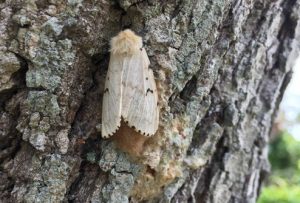N.C. Department of Agriculture to treat spongy moth infestations in Oregon Inlet area, other Dare County sites

Treatments are weather dependent and will likely start in early June. Treatments could continue through June 20.
The areas to be treated include:
- Currituck County
- Dare County
- Rockingham County
- Avery County
- Caldwell County
“We have a total of six blocks and 13,937 acres to treat,” said Sara Lalk, NCDA&CS forest health research operations manager. “We plan to start on May 31 in Currituck and Dare counties, followed by treatment in Rockingham County. We will then start treatment of Avery and Caldwell counties on June 12, adding or subtracting a few days to cover possible weather delays.”
Prior to normal spongy moth mating periods, low-altitude fixed-wing aircraft will disperse SPLAT Gypsy Moth-Organic Mating Disruption infused with the naturally occurring spongy moth pheromone.
The presence of the pheromone makes male spongy moths unable to follow the natural pheromone scent trails released by the females. This causes a decrease in mating success and reduces the spongy moth population. The pheromone is not harmful to humans, animals, or plants, and it will not affect other insect species.
Spongy moths feed on the leaves of more than 300 different species of trees and shrubs, predominantly oaks and hardwoods. When areas become heavily infested, trees may be completely stripped of foliage, leaving yard trees and entire forests more susceptible to attacks from other pests. Severe infestations often lead to tree death. Spongy moth caterpillars can also pose public health concerns for people with respiratory problems. In areas with high-density spongy moth populations, the caterpillar hairs and droppings may cause severe allergic reactions.
NCDA&CS has addressed spot introductions of the spongy moth across North Carolina since the 1970s. The treatment will be done in cooperation with the U.S. Department of Agriculture’s Forest Service.
Homeowners in the treatment areas were notified about these infestations as well as treatment options in February.
The Dare County sites to be treated in 2023 are listed below:
Oregon Inlet area: This 1,670-acre proposed treatment block is in Dare County. This block partially overlays Cape Hatteras National Seashore and includes Billy’s Woods, Bodie Island, the Oregon Inlet Campground, and the Oregon Inlet Fishing Center. The northern edge of this block is at the intersection of South Colony South Drive and South Old Oregon Inlet Road, and the southern edge extends slightly past the end of the Mountains-to-Sea Trail. In 2021, the NCDA&CS captured twelve male moths and in 2022 the number of male moths captured increased to sixty-three male moths, signifying that a reproducing population was present. One application of mating disruption is proposed for this block in late May or early June.
Roanoke Island area: This 674-acre proposed treatment block is in Dare County. The northern edge of this treatment block falls between Jennette’s Pier and US 64, and the southern edge extends just past the South Nags Head Fire Station. In 2021, the NCDA&CS captured thirteen male moths and in 2022, the number increased to thirty-eight male moths captured, signifying that a reproducing population was present. One application of mating disruption is proposed for this block in late May or early June.
Kitty Hawk area: This 7,988-acre proposed treatment block is located in Dare County. This block includes much of the towns of Kitty Hawk, Kill Devil Hills, and Nags Head, as well as Nags Head Woods Preserve, Jockey’s Ridge State Park, Run Hill State Natural Area, the Wright Brothers National Memorial, First Flight Airport, and part of Kitty Hawk Woods Coastal Preserve. The block extends north to the intersection of US 158 and NC 12, and south to the Outer Banks Hospital. In 2021, the NCDA&CS captured thirty-five male moths, and in 2022 the number increased to one hundred and twenty-six male moths captured, signifying that a reproducing population was present. One application of mating disruption is proposed for this block in late May or early June.
For more information, or to request treatment notification via text or email, go to https://www.ncagr.gov/PLANTINDUSTRY/plant/entomology/ProposedSpongyMothTreatments.htm or contact NCDA&CS toll-free at 800-206-9333.












